#comte de rochambeau
Text
I saw @joachimnapoleon’s post wishing French Marshal of the Empire Louis-Alexandre Berthier a happy birthday today (born 20 November 1753), and immediately zoomed in on his participation in the American Revolutionary War under General Rochambeau.
Rochambeau?? Does that mean... he was in Rhode Island?? (FYI my home state where I’m from, for those just tuning in at home)
And yes! Yes he was in Rhode Island!!

Detail of Plan de la position de l'armée françoise autour de Newport et du mouillage de l'escadre dans la rade de cette ville, 1780. (Library of Congress)
Although an author for the map isn’t listed on the LOC, a Rhode Island history site attributes it to Berthier based on “similarities in style and technique with other known Berthier maps and because Colonel Desandroüins was Berthier’s commanding officer.” (omg he drew Easton’s Beach)
I also found an interesting (if somewhat embarrassing) article in the Journal of the American Revolution: Why Newport, Rhode Island, Scorned the French. Basically we were very rude and hostile to General Rochambeau and his entourage because a) the French are CATHOLICS, b) Newport was a hotbed of Loyalists, c) Newport people are just jerks tbh, d) strange fears that the French eat babies?!
#louis-alexandre berthier#american revolution#amrev#rhode island#new england#comte de rochambeau#general rochambeau did get a statue in newport (i didn't know that)#i'm from bristol not newport#who can afford to go to newport#us history#napoleon's marshals
45 notes
·
View notes
Text

1781 07 Washington Reviewing Our Ally-the French - Henry Ogden
Around the turn of the twentieth century, American illustrator Henry A. Ogden painted George Washington reviewing French troops in July 1781 at the encampment at Philipsburg, New York—the first camp shared by the American and French armies during the war. The painting reminds us that the story of how the American and French armies got to Yorktown is just as important to tell as what happened after they arrived. In the watercolor-and-gouache painting the Institute recently acquired, artist Henry A. Ogden focused on the review of the French troops at Philipsburg. He specifically depicted the Soissonnais Regiment—in their white uniforms with pale red facings—marching past the mounted senior officers of the allied armies. It is not clear why Ogden chose to feature the Soissonnais. During the march to Philipsburg, the regiment stood out to Abbé Claude Robin, a chaplain with Rochambeau’s army: “The regiment of Soissonnais has in all this tedious march, had the fewest stragglers and sick of any other;–one of the principal causes was, without doubt, the precaution of the Colonel, who, on purpose for the campaign, had linen breeches made for his whole regiment.” In the painting Ogden included the commanding officer of the Soissonnais, the comte de Saint Maime, walking between the regiment’s flagbearers with his sword raised. General Washington, raising his hat in salute, is flanked by Rochambeau and the chevalier de La Luzerne, French minister to the United States. Next to them, in the foreground of the painting, are Major General Benjamin Lincoln and Brigadier General Henry Knox of the Continental Army, and the duc de Lauzun, a brigadier general of the French army and commander of Lauzun’s Legion. On the opposite side of the marching French troops, Continental Army soldiers, distinguished by their buff-and-blue uniforms, stand in a line watching the review. One of the Continentals carries the American flag pictured at the center of the scene. A camp of white tents appears on a hilltop in the distance.This work celebrates the alliance with France and asserts the importance of the French army’s participation in the Yorktown campaign.
16 notes
·
View notes
Text
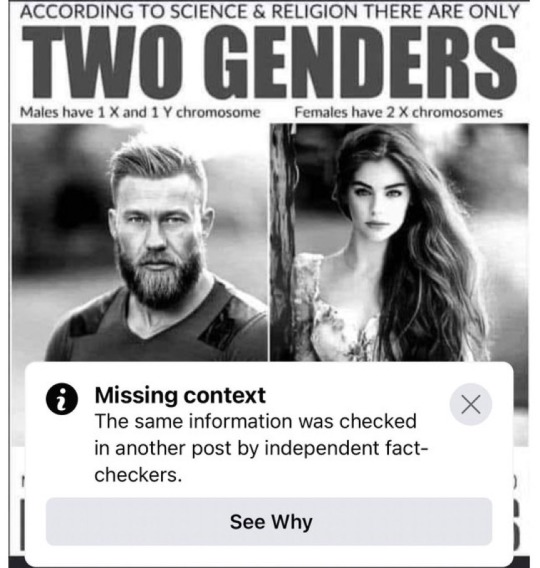
Pour ce qui concerne le délire actuel concernant la confusion entretenue entre sexe et genre, quelques points méritent d’être précisés, à commencer par la différence entre le deux du duel, qui est celui de la dialectique, et la "binarité" dont nous rebattent les oreilles ceux qui prônent le déni de la différence sexuelle et qui font abstraction de l’écart lui-même comme troisième terme entre les hommes et les femmes, comme entre soi et l’Autre...
Relisons Lacan dans Le savoir du psychanalyste:
«Pourquoi est-ce que le psychanalyste s’imagine que ce qui fait le fond de ce à quoi il se
réfère, c’est le sexe? Que le sexe ça soit réel, ceci ne fait pas le moindre doute. Et sa structure même, c’est le duel, le nombre deux. Quoi qu’on en pense, il n’y
en a que deux, les hommes, les femmes, dit-on, et on s’obstine à y ajouter les Auvergnats !
C’est une erreur. Au niveau du réel, il n’y a pas d’Auvergnats*.
Ce dont il s’agit quand il s’agit de sexe, c’est de l’autre, de l’autre sexe, même quand on y préfère le même.»
*Pour la petite histoire, la référence aux "auvergnats" vient de ce qu’en 1781, lors de la bataille de Wethersfield, au général Washington, qui s’émerveillait de ce que "les soldats français combattaient comme des hommes et dansaient comme des femmes", le comte de Rochambeau aurait répondu: "ni hommes ni femmes, ils sont Auvergnats."
Ce qui nous importe ici c’est l’origine du deux. Le deux n’est pas déductible du un. Godel a déjà démontré cela. Il y a deux parce qu’il y a déjà toujours trois. "Jamais deux sans trois" comme dit l’expression. C’est la structure minimale: deux termes et un écart entre eux...
Depuis un certain temps on assiste de la part des séides des Gender Studies, les "étudiants du genre" donc, des "astudés" du Discours Universitaire, avec parmi eux des gens qui se prétendent "psychanalyste" (on aura tout entendu...) et qui parlent de "non binaires", qui prétendent refuser "la binarité"! Mais si "il n’y en a que deux" comme le rappelle Lacan, c’est parce qu’il y aura toujours déjà eu du trois, c’est de dialectique qu’il s’agit: la négation d’une négation ne revient jamais à l’affirmation première...
Par exemple si la relation maître esclave est appelée par Hegel "dialectique", cela tient à l’enjeu du "désir de reconnaissance" et de la "reconnaissance du désir", si le maître se confronte à la mort, il le fait par "pur prestige", tandis que l’esclave, lui, se soumet par peur de la mort sous l’emprise d’une nécessité contingente, ce qui n’offre donc aucune valeur de reconnaissance pour le maître qui ne saurait être reconnu que …par un pair.
Dans la dialectique du maître et de l’esclave, le troisième terme c’est le rapport de négation qui lie les deux et si l’esclave s’échappait ou si le maître défuntait, il n’en resterait pas moins esclave, un esclave sans maître, car il lui eût fallu opérer une seconde négation pour être affranchi de ce qui le détermine comme esclave, ainsi il aura dû non seulement nier le maitre mais aussi se nier lui-même dans son rapport d’esclave. C’est ainsi que ceux qui prétendent échapper à la "binarité" sexuelle non seulement ratent le moment dialectique, mais recréént de facto une binarité entre dominants et soumis au sein même de chaque catégorie "straight" ou "divergent"...
Dans son séminaire sur Les écrits techniques de Freud, Lacan insiste:
«(...) il y a une chose qui est tout à fait certaine, c’est que la relation proprement sadique ne se soutient que pour autant que l’autre est juste à la limite où l’autre reste un sujet.
C’est-à-dire qu’au moment où la souffrance déborde, l’inflexion de la souffrance où l’autre ne devient plus rien qu’une chair qui réagit, une forme de mollusque, dont on titille les bords et qui palpite, il n’y a plus de relation sadique, il peut en sortir quelque chose qui, selon le plus ou moins d’authenticité ou d’ampleur des réalisations dont est capable le sujet sadique, s’arrêtera là, sous une forme tout d’un coup de vide, de béance, de creux.
Mais la relation sadique implique que ce qui est manié dans la relation entre les deux sujets soit quelque chose qui accroche le consentement du partenaire, consentement au sens de l’acceptation la plus large. C’est du consentement, de la liberté, de l’aveu de l’humiliation du partenaire qu’il s’agit.»
Lacan souligne l’incertitude fondamentale de la relation perverse qui ne trouve à s’établir dans aucune action satisfaisante, et ce dans la triade de ces trois registres fondamentalement groupés et développés dans la dialectique du narcissisme que sont la scoptophilie, le sadisme et l’homosexualité.
Le fait que le pervers se fasse instrument de la jouissance de l’Autre empêche que celui qui s’en dit la victime n’ait pas à reconnaître sa part de responsabilité dans le désordre dont il se plaint.
"Tu es une victime!" est le message type du discours dominant, dont le destinataire se comporte effectivement comme s’il était la victime potentielle de forces irrationnelles absurdes, dans un monde devenu fou, dépourvu de sens et dangereux...
Victime, quel avantage, me direz vous?
C’est une échappatoire commode aux affres de la culpabilité!
Coupable, cela veut dire que ce qui nous arrive aura dépendu de nous, donc nous aurions pu faire (et nous pouvons faire) autrement, nous sauver nous-mêmes, en comptant d’abord sur nos propres forces...
Mais notre jouissance de nous maintenir dans notre "minorité" en attendant de l’Autre — l’État le plus souvent, Big Mother... — une réparation pour notre statut de victime, est trop forte, ce qui nous conduit aussi sûrement à la soumission que du bétail à l’abattoir.
Une psychanalyse réussie aura conclu à l’inconsistance du grand Autre, il n’y a pour le sujet rien d’autre au monde qu’un objet petit a...
Le sujet s’y retrouve dès lors conduit à assumer sa responsabilité, ce en quoi il échappe à l’impasse mortifère de l’alternative victimisation/culpabilité: être responsable cela veut simplement dire qu’il accepte de répondre de sa position de sujet comme rejet de la chaîne signifiante, qu’on le veuille ou non, de notre position de sujet, nous sommes toujours responsable, ceci constitue le fondement indépassable de l’éthique, qui est un autre nom pour "lien social" ou "discours" dans sa stricte acception lacanienne.
Le sujet est toujours pris dans un discours, c’est là qu’il apparaît en tant que sujet. L’intersubjectivité imaginaire, cela signifie que l’un des sujets joue le jeu de l’objet. Cela est manifeste dans la notion de regard qui fait que je vois que l’autre me voit, et que tel ou tel tiers intervenant me voit vu. Il n’y a jamais simple duplicité de terme.
Ce n’est pas seulement que je vois l’autre, c’est que je le vois me voir, et que le voyant me voir, ceci implique le troisième terme,
à savoir qu’il sait que je le vois. Le cercle est fermé. Il y a toujours trois termes, même s’il n’y a pas trois termes présents.
Qu’est-ce que ça veut dire ?
Si l’intersubjectivité fondamentale - celle que nous devons retrouver dès l’origine – se manifeste effectivement chez l’enfant, c’est justement le fait qu’il peut se servir du langage.
L’enfant avec ses premiers jeux d’occultation de l’objet manifeste cette sorte de capacité d’appeler la présence dans l’absence,
mais aussi de rejeter l’objet dans la présence, c’est là le phénomène de langage:
ce qui est important,
ce n’est pas qu’il ne tienne pas compte de l’objet, mais qu’il soit capable, en tant que petit animal humain, de se servir de cette fonction
symbolique grâce à laquelle, comme dit Lacan, nous pouvons ici faire entrer les éléphants, quelle que soit l’étroitesse de la porte...
L’intersubjectivité est d’abord donnée avec le maximum d’accent dans le registre du maniement du symbole. Et ceci dès l’origine.
Et c’est justement à partir de là que se produit, d’une façon de plus en plus compliquée, cette sorte d’incarnation du symbolique
dans le vécu imaginaire, qui modèle ensuite d’une certaine façon toutes les inflexions que, dans le vécu de l’adulte, peut prendre
cette sorte d’engagement imaginaire de captation, de fixation, tout ce qui d’abord est parti de cette possibilité de nommer qui est à la fois :
– destruction de la chose,
– et passage de la chose à cet autre plan qui est le plan symbolique, et grâce à quoi le registre proprement humain s’installe.
La relation est intersubjective, essentiellement, et c’est l’amour primordial (primary love) dont se fonde le symbolique en tant que pacte et loi qui se retrouve dans le transfert où l’analyste prend la place de l’objet petit a.
8 notes
·
View notes
Text
Did y'all know that the Comte de Rochambeau's Aide-de-camp was named AXEL?!!?!? What 18th century woman looked at her new born baby and went: "Hm. Yes. AXEL."
1 note
·
View note
Text
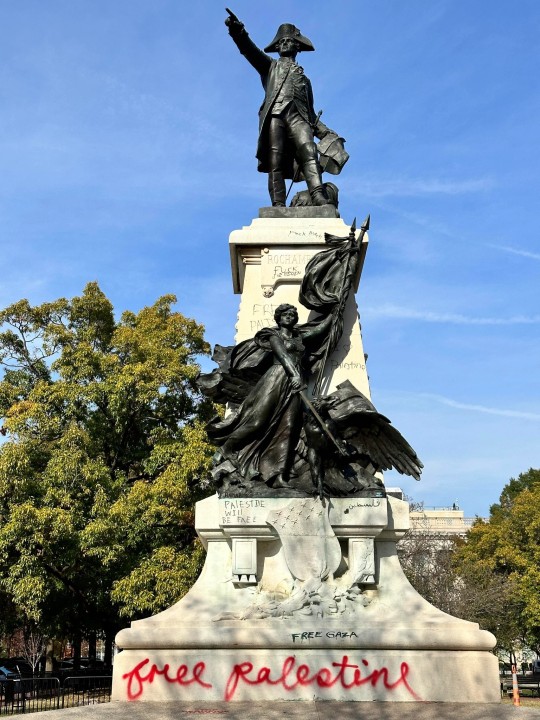
The Comte de Rochambeau Statue in Washington D.C. (to commemorate the French general who was critical to U.S. independence) was defaced yesterday in the pro-Palestine protests.
1 note
·
View note
Link
Check out this listing I just added to my Poshmark closet: First Day Cover Postcard The Landing of Comte De Rochambeau Newport RI 1980.
0 notes
Text
Today In History:

A bit of October 9th history…
1000 - Leif Ericson discovers “Vinland” (possibly L’Anse aux Meadows, Canada), reportedly becoming 1st European to reach North America (pictured)
1781 - Americans under George Washington and the French under Comte de Rochambeau begin bombardment of Yorktown, the last battle of the American Revolutionary War
1888 - Washington Monument opens for public admittance
1936 - Hoover Dam begins transmitting electricity to Los Angeles
1946 - 1st electric blanket manufactured - sold for $39.50
1986 - “The Late Show with Joan Rivers” premiers on FOX, 1st woman to host a US late night TV talk show
2012 - Women’s rights and education activist Malala Yousafzai is shot 3 times by a Taliban gunman as she tried to board her school bus in Pakistan (pictured below)
0 notes
Link
Read the Story & Subscribe For Daily Updates at
TODAYINCTHISTORY.com
#18thcentury #americanrevolution #connecticuthistory #georgewashington #may #militaryhistory #revolutionarywar #rochambeau #washington #wethersfield #yorktown
0 notes
Quote
Cornwallis was not with is army. Pleading illness, he had sent his men out to surrender with General Charles O'Hara at their head. O'Hara made it obvious that they wished to be regarded as surrendering to the French and not to the Americans. Turning to Lafayette's friend Mathieu Dumas, one of Rochambeau's aides assigned to escort him, O'Hara asked where Rochambeau was. On receiving an answer, he started toward the French general. Both Dumas and Rochambeau reminded O'Hara that Washington was the commander-in-chief of the allied army. O'Hara turned to Washington with much embarrassment in his countenance. Washington indicated that he was to take further orders from General Lincoln, who had had to surrender his own army at Charleston. Lincoln led the British and Hessians through the lines of their conquerors. They kept their eyes turned towards the French ranks, until Lafayette, resenting their studied disregard, ordered his drum-major to strike up 'Yankee Doodle.' The band's blare made them turn their eyes toward his side of the line.
Lafayette In America by Louis Gottschalk, The Siege of Yorktown, pg. 326.
🎶 The Yankee Doodle incident. 🎶
#Marquis de Lafayette#Lafayette#Lafayette In America#Louis Gottschalk#Battle of Yorktown#pg. 326#Charles Cornwallis#Charles O'Hara#Mathieu Dumas#Comte de Rochambeau#George Washington#Benjamin Lincoln#Yankee Doodle
56 notes
·
View notes
Text
Today I learned:
Count Axel von Fersen (one of Marie Antoinette’s rumored lovers) was one of Rochambeau’s aides-de-camp during the American Revolution.
All these connections are so fascinating!
#axel von fersen#history#amrev#comte de rochambeau#that’s so neat omg#american revolution#marie antoinette
29 notes
·
View notes
Text
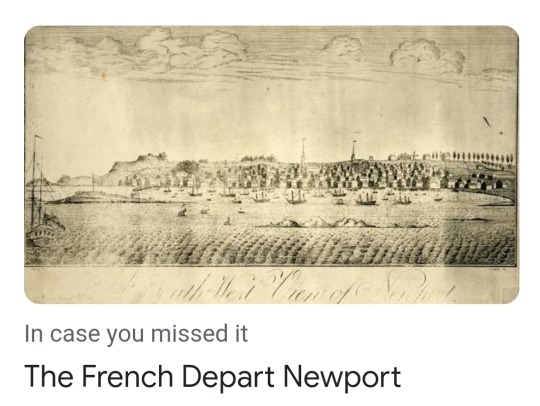
Yes, I missed it. Are you happy now?? I left Rhode Island 10 years ago when I got engaged and now the French are gone from Newport.
It feels unreal. The whole time I was growing up you could visit Lieutenant General Jean Baptiste Donatien de Vimeur Comte de Rochambeau at his big encampment there—you might even see Louis Alexandre Berthier making a map! All the tourist traps would be full of French officers, looking to purchase horses or complaining about the American militiamen. It was hilarious if you were in a shop full of French officers and then a Loyalist family came in!
And now they're just... gone. I don't know how to feel about this.
26 notes
·
View notes
Text
hamilton: i’m claustrophobic.
rochambeau: what does that mean?
lafayette: it means he’s afraid of santa claus!
31 notes
·
View notes
Text
24 Days of La Fayette: December 9th - Comte de Charlus
Armand-Charles-Augustin de La Croix de Castries, comte de Charlus was a French nobleman that served as a Colonel en Second in the Saintonge Regiment. The Regiment was founded as the 85e Regiment of the Line in 1684. In 1780, during the Revolutionary War it was dispatched to the former colonies under the command of the comte de Rochembeau and participated in the battle of Yorktown. After the French Revolution, the regiment was transformed into the 82e Regiment of Infantry.
Charlus was born on May 23, 1756 as the oldest son of Charles Eugène Gabriel de La Croix de Castries, marquis de Castries (1727-1801) and Gabrielle Isabeau Thérèse de Rosset. Castries served as Secretray of the French Navy from 1780 until 1787. He was made a Marshal of France in 1783.
The Marquis de Chastellux described Charlus career and character as follows in a letter to George Washington from January 12, 1781:
Count de Charlus the son of marquis de Castries our new minister is a young gentleman endowed with the best and most amiable qualities, but i may do him justice in a word by saying that he is a worthy friend to marquis de la fayette. he resigned a colonelship at home to serve in America and left in france a very handsome lady whom he had married the month before. I hope that he will testify to your excellency the respect and the attachment of the whole french army (…).
"To George Washington from François-Jean de Beauvoir, marquis de Chastellux, 12 January 1781,” Founders Online, National Archives, [This is an Early Access document from The Papers of George Washington. It is not an authoritative final version.] (09/09/2022)
Charlus had already been a friend of La Fayette when he came over with his regiment, but their relationship deepened after Charlus offered his service as a volunteer aide-de-camp in March of 1781. The comte de Charlus joined La Fayette along with the comte de Dillon and the comte (?) de Sainte-Maime. All three men were friends of La Fayette and joined him in order to support his expedition against Benedict Arnold in Virginia. It appears that only Charlus served directly as an aide-de-camp. By April of the same years, the three men had left Virginia for Rhode Island, making Charlus’ service a rather short one.
La Fayette wrote in a letter to George Washington dated February 24, 1781:
Count de Ste Mîme and Mons. de St Victor are with me-- They ask Your permission to follow me and so will Count de Charlus &c. -- I told them that You would Have No objection to it As far as may Be Consistent with their Arrangements with Count de Rochambeau upon which You will not Intrude, and that the American Army will Be Happy in all times to Be Honor’d with the visit of Such Volonteers-- But these Expressions will still do Better from You, and the word Volonteer must not Be forgotten for Reasons obvious in any thing You’ll order me to Answer to them.
"To George Washington from Marie-Joseph-Paul-Yves-Roch-Gilbert du Motier, marquis de Lafayette, 24 February 1781,” Founders Online, National Archives, [This is an Early Access document from The Papers of George Washington. It is not an authoritative final version.] (09/09/2022)
La Fayette described the whole situation further in a letter to the Prince de Poix from August 24, 1781:
You will already have learned that Charlus came to Virginia with me. He had permission to travel, but they compelled him to return nonetheless, an event that has not affected him very much.
Idzerda Stanley J. et al., editors, Lafayette in the Age of the American Revolution: Selected Letters and Papers, 1776–1790, Volume 4, April 1, 1781–December 23, 1781, Cornell University Press, 1981, p. 356-349.
La Fayette and Charlus were reunited for the Battle of Yorktown although they were not directly serving together. We have previous letters where La Fayette expresses his warm feelings for Charlus but his letter from October 20, 1781 is my favourite example of these warm feelings. La Fayette wrote to the Prince de Poix:
I become more and more attached to Charlus. To the distinguished qualities that make him esteemed, he joins all those that make him loved. (…) Charlus, the vicomte, Damas, and I live as intimately together as in Paris.
Idzerda Stanley J. et al., editors, Lafayette in the Age of the American Revolution: Selected Letters and Papers, 1776–1790, Volume 4, April 1, 1781–December 23, 1781, Cornell University Press, 1981, p. 424-425.
Shortly after the Battle of Yorktown, Charlus returned to France where his military career continued to thrive. La Fayette wrote in a letter to George Washington on January 18, 1782:
Charlus is adjutant General of the Gendarmerie of France Which his Father Commands.
"To George Washington from Marie-Joseph-Paul-Yves-Roch-Gilbert du Motier, marquis de Lafayette, 18 January 1782,” Founders Online, National Archives, [This is an Early Access document from The Papers of George Washington. It is not an authoritative final version.] (09/09/2022)
The Marquis mentioned Charlus career again in a letter to George Washington from May 24, 1786:
Count de charlus, now Called duke de Castries, is Commander in second of the Gendarmerie which is Commanded by His father.
“To George Washington from Lafayette, 24 May 1786,” Founders Online, National Archives, [Original source: The Papers of George Washington, Confederation Series, vol. 4, 2 April 1786 – 31 January 1787, ed. W. W. Abbot. Charlottesville: University Press of Virginia, 1995, pp. 71–73.] (09/09/2022)
Their apparent closeness should make for a great friendship between La Fayette and Charlus, should it not? Well, let me introduce you to a little something called the French Revolution.
Charlus was initially quite positive towards the Revolution and even supported the abolishing of privileges for the nobility – at heart he however remained the most astute royalist. It did not took him and La Fayette too long to clash over the politic of the Revolution. Charlus even duelled Charles Lameth, the brother of Alexandre Lameth, La Fayette’s fellow prisoner. Lameth was slightly wounded during the duel.
Charlus fled to Coppet in Switzerland where he had family and joined the Armée des émigrés in 1794 and founded his own regiment. He only returned back to France after the Restauration in 1814. He died on January 19, 1842.
Charlus had a younger sister, Adélaïde Marie de La Croix de Castries, who married the Vicomte de Mailly in 1767. He had been married twice and each marriage produced one surviving son. He was succeeded by his first born son, Edmond Eugène Philippe Hercule de La Croix de Castries.
#24 days of la fayette#marquis de lafayette#la fayette#french history#american history#american revolution#french revolution#letter#history#lafayette's aide-de-camps#comte de charlus#george washington#founders online#marquis de chastellux#1781#1782#1786#1842#1756
9 notes
·
View notes
Text

«Que le sexe ça soit réel, ceci ne fait pas le moindre doute. Et sa structure même, c’est le duel, le nombre deux. Quoi qu’on en pense, il n’y en a que deux, les hommes, les femmes, dit-on, et on s’obstine à y ajouter les Auvergnats!
C’est une erreur. Au niveau du réel, il n’y a pas d’Auvergnats.
Ce dont il s’agit quand il s’agit de sexe, c’est de l’autre, de l’autre sexe, même quand on y préfère le même.»
(JL, Le savoir du psychanalyste)
*La référence aux "auvergnats" vient de ce qu’en 1781, lors de la bataille de Wethersfield, au général Washington, qui s’émerveillait de ce que "les soldats français combattaient comme des hommes et dansaient comme des femmes", le comte de Rochambeau aurait répondu: "ni hommes ni femmes, ils sont Auvergnats."
7 notes
·
View notes
Text
I scanned in all the papers from the Lafayette plate set I got, so here they are!
These are the sketches
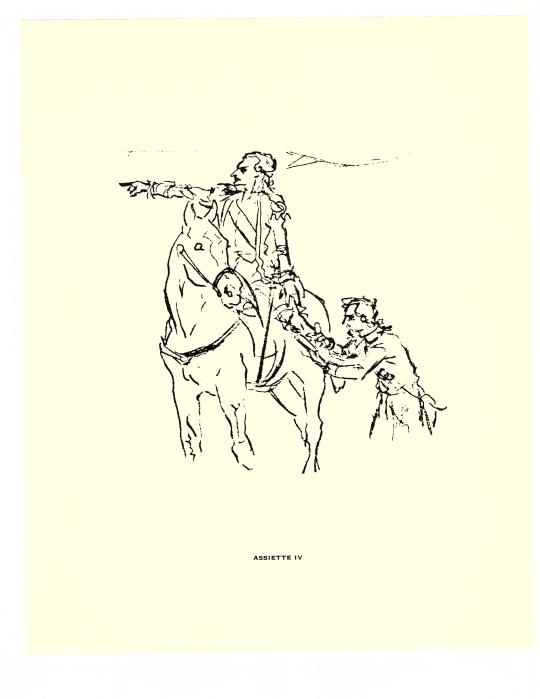




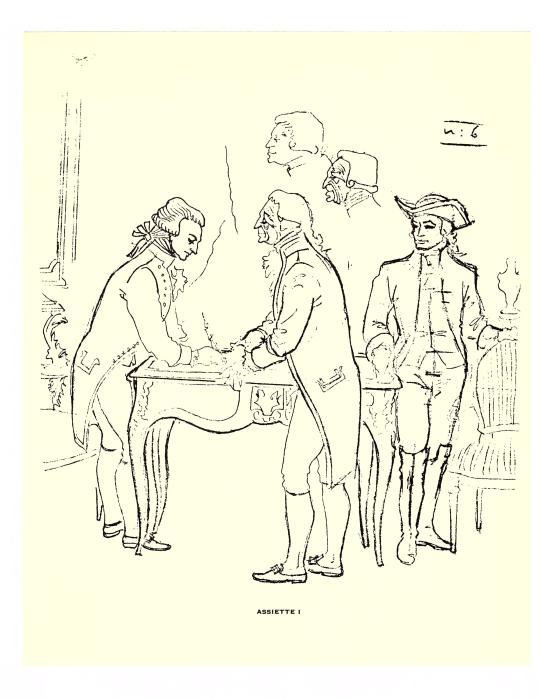

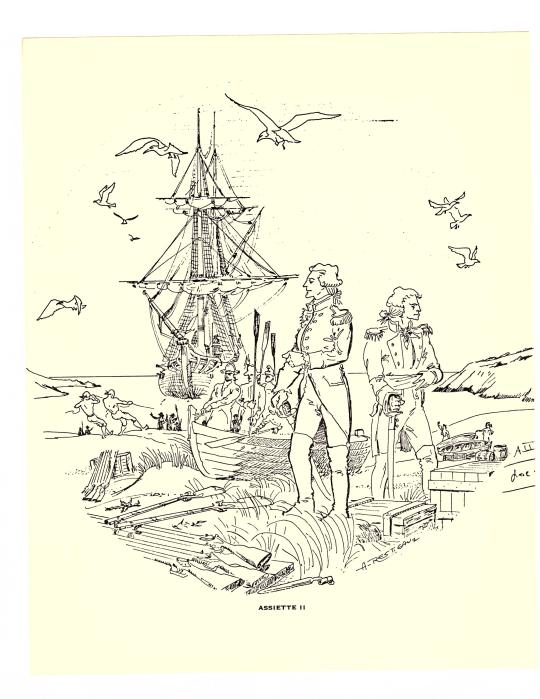




This is the only plate explanation I got
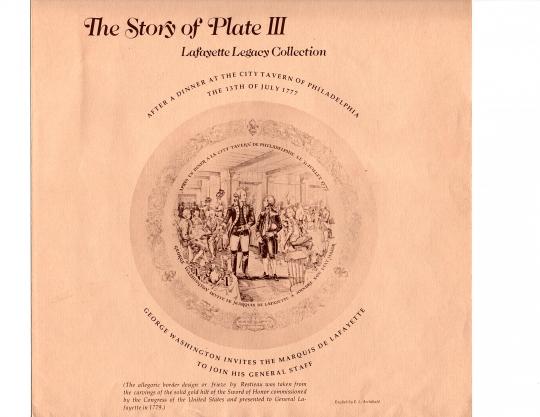


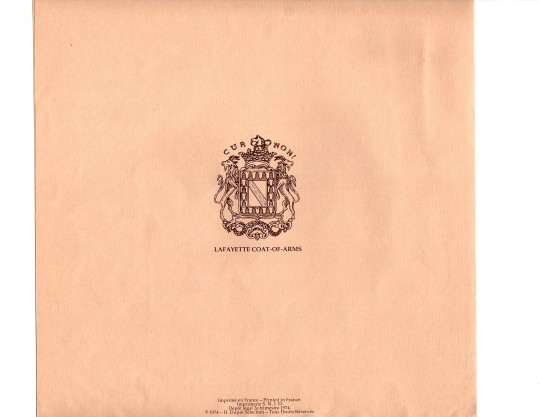
And here’s the certificate!

#mine#I'm immeasurably happy y'all#like the artist didn't have to make his nose that prominent but they did and I hjkshdfjds#my mans had a big nose okay I think it's cute#marquis de lafayette#benjamin franklin#comte de rochambeau#george washington
15 notes
·
View notes
Photo
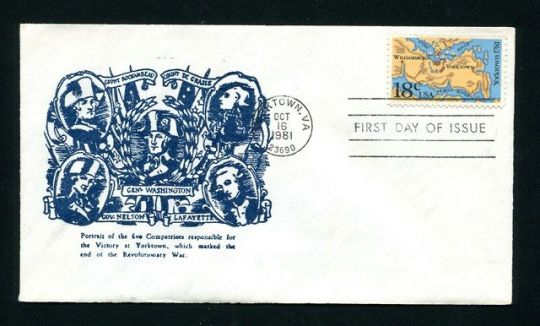
Yorktown commemorative cover, 1981 featuring Washington, Lafayette, Rochambeau, de Grasse and Nelson
#George Washington#Gilbert du Motier Marquis de Lafayette#General Lafayette#Comte de Rochambeau#Battle of Yorktown
30 notes
·
View notes